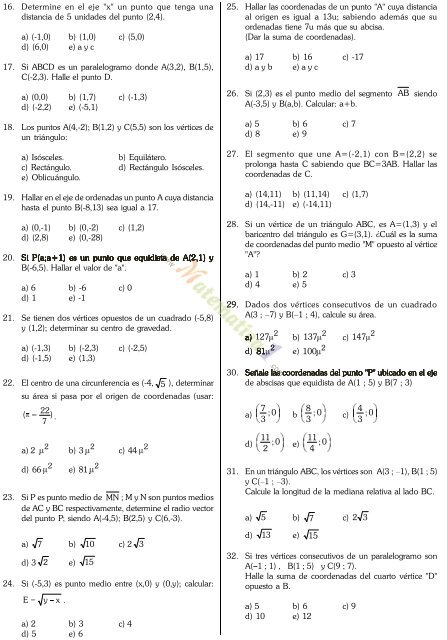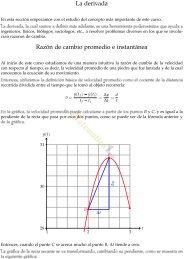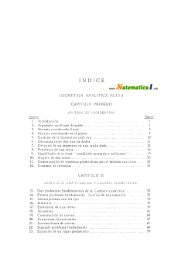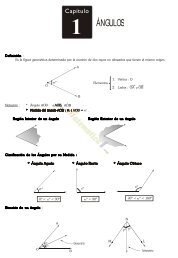libro de trigonometria preuniversitaria nivel uni click aqui para ver
libro de trigonometria preuniversitaria nivel uni click aqui para ver
libro de trigonometria preuniversitaria nivel uni click aqui para ver
You also want an ePaper? Increase the reach of your titles
YUMPU automatically turns print PDFs into web optimized ePapers that Google loves.
16. Determine en el eje "x" un punto que tenga una<br />
distancia <strong>de</strong> 5 <strong>uni</strong>da<strong>de</strong>s <strong>de</strong>l punto (2,4).<br />
a) (-1,0) b) (1,0) c) (5,0)<br />
d) (6,0) e) a y c<br />
17. Si ABCD es un <strong>para</strong>lelogramo don<strong>de</strong> A(3,2), B(1,5),<br />
C(-2,3). Halle el punto D.<br />
a) (0,0) b) (1,7) c) (-1,3)<br />
d) (-2,2) e) (-5,1)<br />
18. Los puntos A(4,-2); B(1,2) y C(5,5) son los vértices <strong>de</strong><br />
un triángulo:<br />
a) Isósceles. b) Equilátero.<br />
c) Rectángulo. d) Rectángulo Isósceles.<br />
e) Oblicuángulo.<br />
19. Hallar en el eje <strong>de</strong> or<strong>de</strong>nadas un punto A cuya distancia<br />
hasta el punto B(-8,13) sea igual a 17.<br />
a) (0,-1) b) (0,-2) c) (1,2)<br />
d) (2,8) e) (0,-28)<br />
20. Si P(a;a+1) es un punto que equidista <strong>de</strong> A(2,1) y<br />
B(-6,5). Hallar el valor <strong>de</strong> "a".<br />
a) 6 b) -6 c) 0<br />
d) 1 e) -1<br />
21. Se tienen dos vértices opuestos <strong>de</strong> un cuadrado (-5,8)<br />
y (1,2); <strong>de</strong>terminar su centro <strong>de</strong> gravedad.<br />
a) (-1,3) b) (-2,3) c) (-2,5)<br />
d) (-1,5) e) (1,3)<br />
22. El centro <strong>de</strong> una circunferencia es (-4, 5 ), <strong>de</strong>terminar<br />
su área si pasa por el origen <strong>de</strong> coor<strong>de</strong>nadas (usar:<br />
(<br />
22<br />
) .<br />
7<br />
a) 2<br />
2<br />
d) 66 2<br />
b) 3 2<br />
e) 81 2<br />
c) 44 2<br />
23. Si P es punto medio <strong>de</strong> MN ; M y N son puntos medios<br />
<strong>de</strong> AC y BC respectivamente, <strong>de</strong>termine el radio vector<br />
<strong>de</strong>l punto P; siendo A(-4,5); B(2,5) y C(6,-3).<br />
a) 7 b) 10 c) 2 3<br />
d) 3 2 e) 15<br />
24. Si (-5,3) es punto medio entre (x,0) y (0,y); calcular:<br />
E y x .<br />
a) 2 b) 3 c) 4<br />
d) 5 e) 6<br />
25. Hallar las coor<strong>de</strong>nadas <strong>de</strong> un punto "A" cuya distancia<br />
al origen es igual a 13u; sabiendo a<strong>de</strong>más que su<br />
or<strong>de</strong>nadas tiene 7u más que su abcisa.<br />
(Dar la suma <strong>de</strong> coor<strong>de</strong>nadas).<br />
a) 17 b) 16 c) -17<br />
d) a y b e) a y c<br />
26. Si (2,3) es el punto medio <strong>de</strong>l segmento AB siendo<br />
A(-3,5) y B(a,b). Calcular: a+b.<br />
a) 5 b) 6 c) 7<br />
d) 8 e) 9<br />
27. El segmento que une A=(-2,1) con B=(2,2) se<br />
prolonga hasta C sabiendo que BC=3AB. Hallar las<br />
coor<strong>de</strong>nadas <strong>de</strong> C.<br />
a) (14,11) b) (11,14) c) (1,7)<br />
d) (14,-11) e) (-14,11)<br />
28. Si un vértice <strong>de</strong> un triángulo ABC, es A=(1,3) y el<br />
baricentro <strong>de</strong>l triángulo es G=(3,1). ¿Cuál es la suma<br />
<strong>de</strong> coor<strong>de</strong>nadas <strong>de</strong>l punto medio "M" opuesto al vértice<br />
"A"?<br />
a) 1 b) 2 c) 3<br />
d) 4 e) 5<br />
29. Dados dos vértices consecutivos <strong>de</strong> un cuadrado<br />
A(3 ; 7) y B( 1 ; 4), calcule su área.<br />
a) 127<br />
2<br />
b) 137<br />
2<br />
c) 147<br />
2<br />
d) 81<br />
2<br />
e) 100<br />
2<br />
30. Señale las coor<strong>de</strong>nadas <strong>de</strong>l punto "P" ubicado en el eje<br />
<strong>de</strong> abscisas que equidista <strong>de</strong> A(1 ; 5) y B(7 ; 3)<br />
a)<br />
d)<br />
7<br />
; 0<br />
3<br />
11<br />
; 0<br />
2<br />
b<br />
e)<br />
8<br />
; 0<br />
3<br />
11<br />
; 0<br />
4<br />
c)<br />
4<br />
; 0<br />
3<br />
31. En un triángulo ABC, los vértices son A(3 ; 1), B(1 ; 5)<br />
y C( 1 ; 3).<br />
Calcule la longitud <strong>de</strong> la mediana relativa al lado BC.<br />
a) 5 b) 7 c) 2 3<br />
d) 13 e) 15<br />
32. Si tres vértices consecutivos <strong>de</strong> un <strong>para</strong>lelogramo son<br />
A( 1 ; 1) , B(1 ; 5) y C(9 ; 7).<br />
Halle la suma <strong>de</strong> coor<strong>de</strong>nadas <strong>de</strong>l cuarto vértice "D"<br />
opuesto a B.<br />
a) 5 b) 6 c) 9<br />
d) 10 e) 12







